Promotion of Diversity
With our longstanding job-centered emphasis on the division of roles and results as a foundation, the Tsubaki Group has been promoting reforms to our personnel management system with diversity in mind.
Since FY 2018, Tsubakimoto Chain has been moving ahead with work style reforms. Along with rolling out various measures to realize efficient and flexible work styles, our Labor/Management Joint Committee is collaborating to implement initiatives to reduce excessively long work hours and promote the utilization of paid vacation time.
We will continue to implement a range of measures to support efficient and flexible work styles.
-
Composition of Employees by Region
(as of March 31, 2023)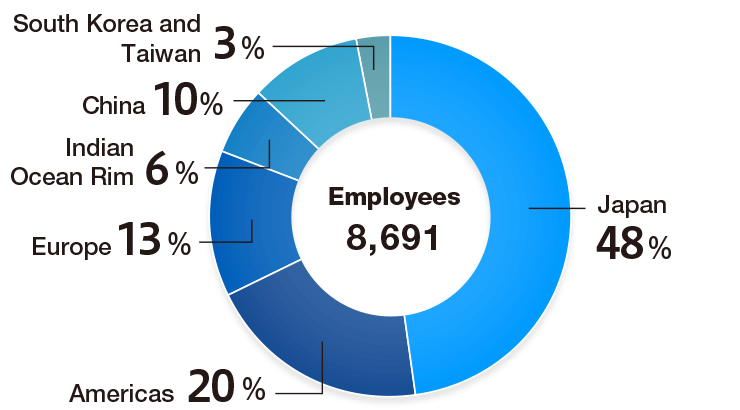
-
Ratio of Paid Leave Acquisition
(Tsubakimoto Chain, non-consolidated)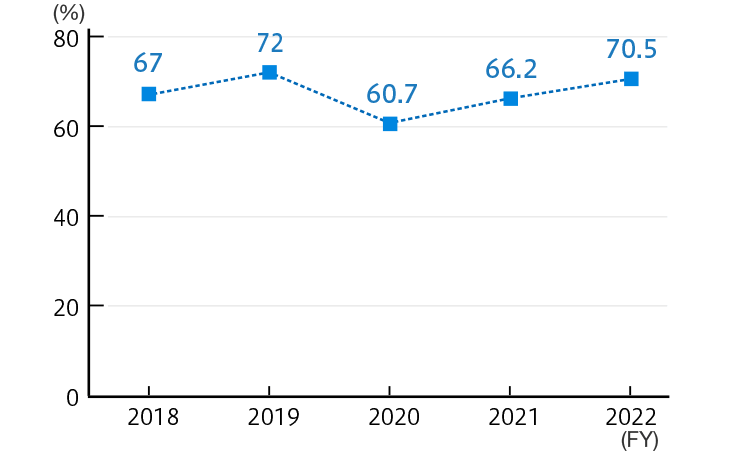
Initiatives
(1) Active Participation of Women
At Tsubakimoto Chain, we have been pioneers in introducing equal wages for men and women, and we have put in place a personnel management system where women can comfortably continue to work even during life events such as pregnancy and childbirth. We are aiming to further increase the percentage of women at the company (9.6% as of April 1, 2023) by actively encouraging applications from various high schools and universities. At the same time, we are enabling women to deepen their understanding of our work environment through efforts that include women introducing their jobs at explanatory meetings. In addition, we are advancing the promotion of women by proactively providing opportunities for promotion to outstanding employees, irrespective of gender.
In FY 2022, the rate of return to work after taking maternity/childcare leave was 97.2%, clearly indicating that we have succeeded in creating a workplace environment that facilitates women returning to work after giving birth. This includes making it easier to take childcare leave by raising awareness in the company and educating management-level employees, and promoting work style reforms. We also saw a dramatic increase in the number of male employees taking childcare leave in FY 2022 (29 people, rate of taking leave of 27.1%)
-
Ratio of Female Employees in Senior Roles and Number of Female Employees in Managerial Roles
(Domestic)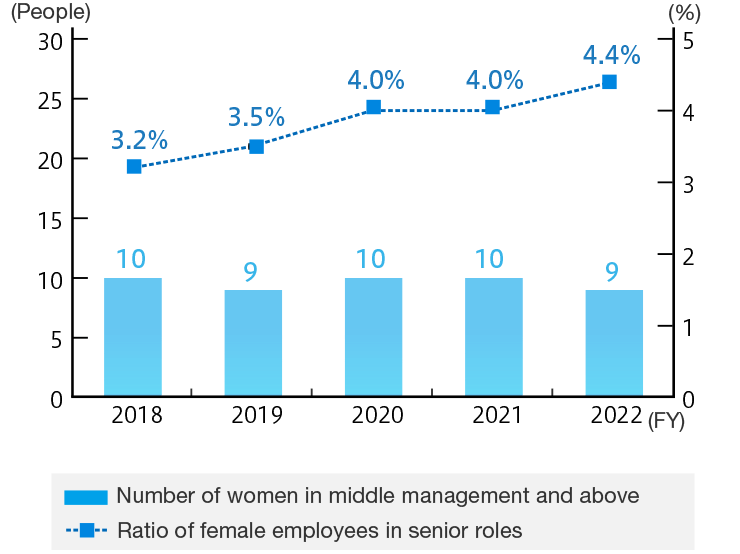
-
Number of Employees Who Acquired Childcare Leave (Tsubakimoto Chain, non-consolidated)
FY 2018 FY 2019 FY 2020 FY 2021 FY 2022 Women 7 1 5 1 3 Men - 5 4 5 29
(2) Promotion of the Employment of People with Disabilities
The Tsubaki Group is striving to expand work duties available for people with disabilities and create an environment where they can work together with other employees.
In 2020 we established a special subsidiary to promote the employment of people with disabilities, and we have been enhancing the support systems and actively expanding employment opportunities for them. We are working to provide people with disabilities a wide range of work roles where they can use their individual attributes, including manufacturing worksites, administrative work, facility maintenance and management, and health management.
Additionally, we have been creating a comfortable workplace environment at the Saitama Plant, including setting up a special yard area for people with disabilities.
Thanks to these initiatives, for the past three consecutive years we have been employing people with disabilities at the company at a rate that is above the legally required employment ratio. We will continue to expand the employment of people with disabilities, positioning it at the core of the promotion of diversity in the company.
-
Ratio of employees with disabilities
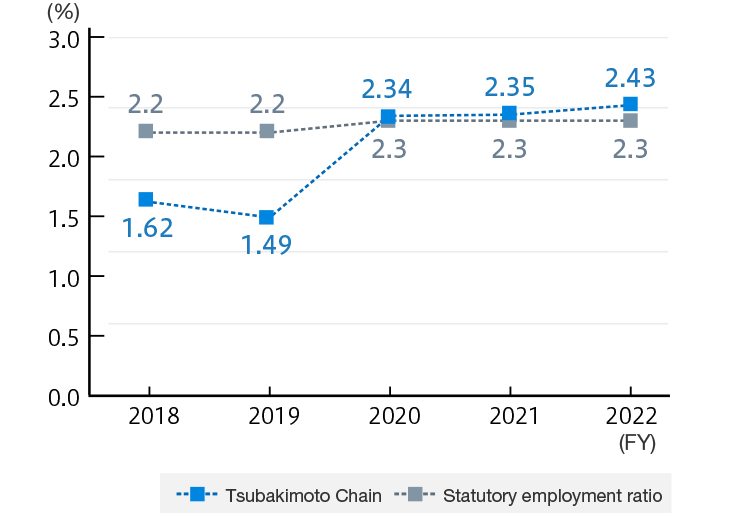
An Outline of Our Special Subsidiary (Tsubaki Support Center Co.)
Tsubaki Support Center is a Tsubakimoto Chain subsidiary that was established primarily to handle welfare and outsourced operations. In FY 2020, it was certified as a special subsidiary of Tsubakimoto Chain, and initiated business services by persons with disabilities. The company provides a comfortable working environment and jobs that allow each individual to play an active role according to his or her abilities and talents. It also has a support system in place that allows each employee to demonstrate his or her abilities. (Currently employs seven trainers and six disability vocation and lifestyle counselors.)
Their current duties include manufacturing, printing, scanning, and tidying up. In our cleaning operations, we have invited outside instructors to help workers improve their skills with the goal of competing in the Abilympics* regional competition. In the future, we intend to expand into the services sector. By proactively employing people with disabilities, we are fulfilling our responsibility to society.
Our initiatives have been recognized, and in 2022 we received the Kyoto Prefecture Governor’s Award for Excellent Employment of People with Disabilities, and we were certified as a Company Promoting the Employment of People with Disabilities in Kyoto Prefecture (Kyoto Heartful Company).
* Abilympics: A competition in which people with disabilities compete with the skills they have developed on a daily basis
-
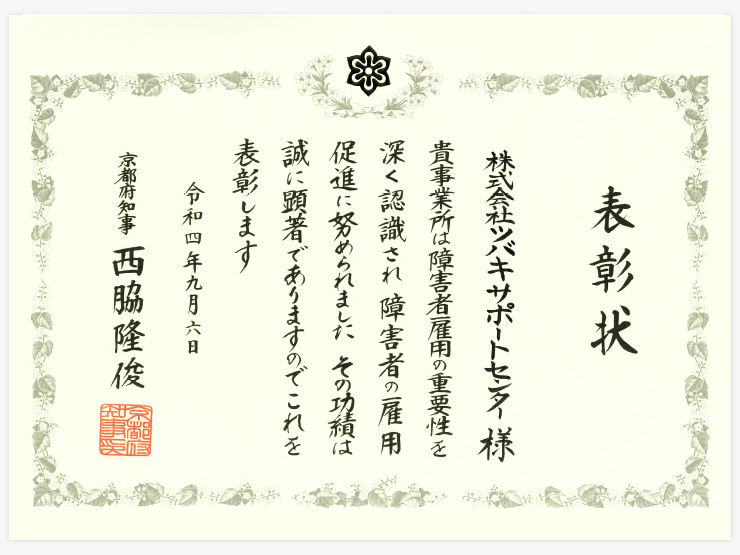
Kyoto Prefecture Governor’s Award -
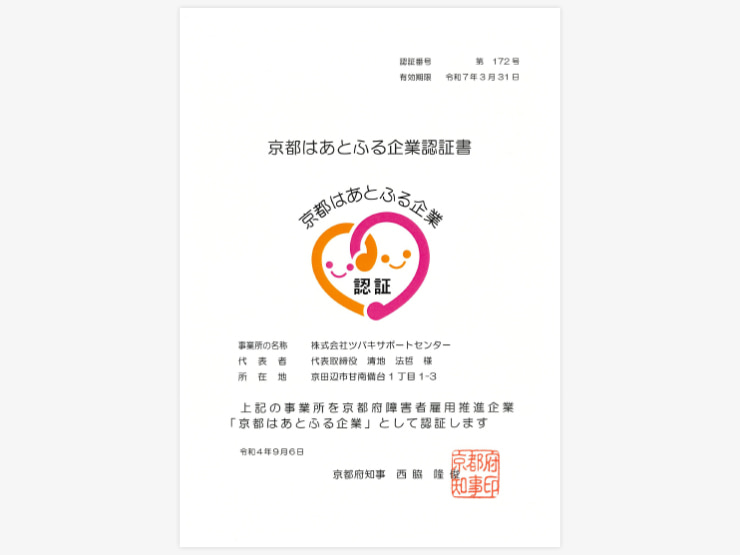
Certified as a Kyoto Heartful Company
(3) Active Participation of Seniors
In April 2020, we introduced an Age 65 Retirement System, that extends the retirement age from 60 to 65 years old. With the introduction of a new retirement age of 65, we have also improved our treatment of older employees. As a result, we have maintained a high rate of continuous employment of around 85% since the introduction of the system. We also enhanced our career training program for employees at the age of 50. The content has been revised to encourage people to maintain their desire to work and to continue learning until age 65, and we also provide support by raising awareness of the opportunities available.
(4) Expanding the employment of non-Japanese
We have been striving to expand the employment of non-Japanese with the aim of introducing diverse ways of thinking to stimulate innovation and business growth. Our target for FY 2030 is to employ 85 non-Japanese (31 non-Japanese employees at the company as of March 31, 2023). We employed four mid-career non-Japanese employees in FY 2022, and three new graduate non-Japanese employees in April 2023.
FY 2022 Topics
Launch of Tsubaki Style to Encourage Free Thought
We have introduced hot desking in the head office and Osaka and Tokyo branch offices to create an office layout that promotes better communication and work efficiency.
In April 2023, we launched Tsubaki Style to create a flexible and lively workplace culture. This system fosters a creative and free-thinking work culture by encouraging employees to use informal titles like 'xx-san' when addressing each other and promoting a smart-casual dress code at our branches and sales offices. We firmly believe that by nurturing a more open, flexible, and relaxed work environment, we can stimulate the generation of innovative products and ideas.
In April 2023, we also fully launched a work-from-home system that reflects the work styles during and after the COVID-19 pandemic.
Encouraging Male Employees to Take Childcare Leave
As a part of our efforts to provide support for balancing childcare with work, the Human Resources Department has been carrying out awareness-raising activities so that the maternity and childcare leave systems are properly understood and widely utilized. To encourage male employees to take childcare leave, we are implementing initiatives such as checking if employees intend to take childcare leave when their child is born, including information in the company newsletter about the company’s policies on support for balancing childcare with work, and education for executive-level employees on the childcare leave system and harassment. As a result, in FY 2022 the ratio of male employees taking childcare leave was 27.1%, which was a huge jump from the FY 2021 ratio of 7.5%.
Having a variety of people taking childcare leave is expected to promote a review of work procedures and work styles. It will also encourage mutually supportive relationships within the workplace. We are committed to creating a vibrant workplace where a diverse workforce can play an active role.



